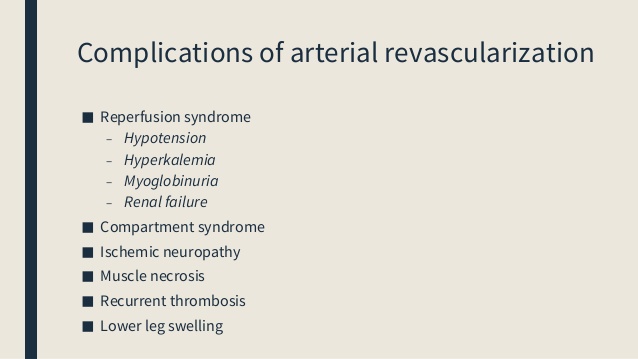Reperfusion injury natural history: Difference between revisions
Jump to navigation
Jump to search
| Line 20: | Line 20: | ||
* Those [[patients]] who are identified and treated early, the [[prognosis]] is better along with the decreased [[incidence]] of [[Intracranial hemorrhage|intracranial]] hemorrhage. Outcomes usually depend on the timely recognition and prevention of precipitating factors. [[Hypertension]] management is most important before it can inflict damage in the form of [[edema]] or [[hemorrhage]] | * Those [[patients]] who are identified and treated early, the [[prognosis]] is better along with the decreased [[incidence]] of [[Intracranial hemorrhage|intracranial]] hemorrhage. Outcomes usually depend on the timely recognition and prevention of precipitating factors. [[Hypertension]] management is most important before it can inflict damage in the form of [[edema]] or [[hemorrhage]] | ||
*The prognosis following [[hemorrhagic]] transformation is poor. [[Mortality]] in such cases is 3663%, and 80% of survivors have significant [[morbidity]]. | *The prognosis following [[hemorrhagic]] transformation is poor. [[Mortality]] in such cases is 3663%, and 80% of survivors have significant [[morbidity]]. | ||
*In case of [[Central nervous system]] the [reperfusion]] is mainly associated with the development of [[cerebral ischemia]] with the presentation mainly as [[stroke]], [[TIA]], and other [[neurological]] deficits with a bad prognosis | *In case of [[Central nervous system]] the [[reperfusion]] is mainly associated with the development of [[cerebral ischemia]] with the presentation mainly as [[stroke]], [[TIA]], and other [[neurological]] deficits with a bad prognosis | ||
*In [[CVS]] patients [[reperfusion]] injury is mainly associated with [[Arrhythmias]], [[myocardial stunning]], and [[myocyte death]], which mainly results in the occurrence of [[Myocardial Infarction]] with a worse [[prognosis]]. | *In [[CVS]] patients [[reperfusion]] injury is mainly associated with [[Arrhythmias]], [[myocardial stunning]], and [[myocyte death]], which mainly results in the occurrence of [[Myocardial Infarction]] with a worse [[prognosis]]. | ||
Revision as of 03:07, 20 August 2020
Editors-In-Chief: Anjan K. Chakrabarti, M.D. [1]; C. Michael Gibson, M.S., M.D. [2]; Associate Editor(s)-in-Chief: Shivam Singla, M.D.[3] Kashish Goel, M.D ;
Natural History
Complications

Myocardial stunning: It is mainly defined as an abnormality in the contractile function of myocardium that sometimes persists even after the return of reperfusion and resolution of ischemia. It is mainly due to the release of reactive oxygen species and intracellular calcium overload.
- Myocardial infarction: Irreversible myocyte cell death secondary to reduced oxygen delivery for more than 20-30 minutes, will lead to infarction. Reperfusion helps prevent complete loss of the involved area, however oxidative stress due to this may prevent complete resolution.
- Acute heart failure: Loss of myocardial contractility and systolic dysfunction associated with ischemia/reperfusion injury may lead to the development of acute heart failure. Early reperfusion in the course of STEMI prevents myocardial necrosis and may lead to complete recovery of function.
- Ventricular arrhythmias: Reperfusion of the blocked coronary artery can also precipitate arrhythmias ranging from ventricular premature beats to life-threatening ventricular fibrillation.
Prognosis
Prognosis in CNS patients
- Those patients who are identified and treated early, the prognosis is better along with the decreased incidence of intracranial hemorrhage. Outcomes usually depend on the timely recognition and prevention of precipitating factors. Hypertension management is most important before it can inflict damage in the form of edema or hemorrhage
- The prognosis following hemorrhagic transformation is poor. Mortality in such cases is 3663%, and 80% of survivors have significant morbidity.
- In case of Central nervous system the reperfusion is mainly associated with the development of cerebral ischemia with the presentation mainly as stroke, TIA, and other neurological deficits with a bad prognosis
- In CVS patients reperfusion injury is mainly associated with Arrhythmias, myocardial stunning, and myocyte death, which mainly results in the occurrence of Myocardial Infarction with a worse prognosis.